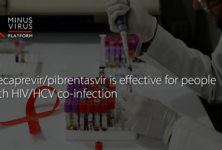Researchers from the Dutch pre-exposure prophylaxis (PrEP) demonstration study, AmPrEP, have found an unexpectedly high rate of hepatitis C virus (HCV) infection in participants tested for it at baseline.
The HCV prevalence seen was more typical of that seen in HIV-positive gay men rather than the much lower rates seen in HIV-negative men.
Presenter Maria Prins said that phylogenetic mapping suggested that the explanation might lie in study participants being more likely to have condomless sex with men of HIV-positive or unknown status, amongst whom HCV prevalence was higher than other HIV-negative men.
One unanswered question is whether this might in future lead to a general increase in HCV prevalence among the HIV-negative gay population, or whether PrEP users were a specific population that were untypical of other HIV-negative gay men.
Prins said her data did suggest that hepatitis C screening and regular testing should become the norm among gay men seeking and taking PrEP. She added that if at-risk men were screened regularly and provided with early HCV treatment, the highly effective and swift-acting new HCV direct-acting antiviral drugs would have a chance to bring about a rapid reduction in overall HCV prevalence within the gay community, by acting as hepatitis C ‘treatment as prevention’.
Background: hepatitis C prevalence in HIV-negative and HIV-positive gay men
Historically, the risk of HCV infection via sex in HIV-negative people has been seen as low. US guidelines still state that the risk of infection even in people with multiple partners or with a partner with HCV is ‘low’ and that screening or regular testing is not recommended.
They do, however, add that the risk of infection may be higher where HIV or bacterial sexually transmitted infections (STIs) are present, or where sex has been rough or traumatic. A Dutch study of gay men with HIV who contracted HCV found that men who had injected drugs were 16 times more likely to become infected. However, it also found the risk of HCV was six times higher in men who had had unprotected receptive anal intercourse in the last six months, five times higher if they had had an ulcerative STI, four times higher if sex toys had been used, and three times higher if there had been fisting or if coke straws were used. Having had multiple partners in itself did not confer extra risk.
Hepatitis C is much more common in HIV-positive gay men than in HIV-negative. A number of studies from Europe and North America have found that in the region of 6.5% of HIV-positive gay men have chronic hepatitis C at any one time and that gay men with HIV are 7.5 times more likely to have hepatitis C than men without HIV. Infection rates have been rising in HIV-positive gay men over time (see below).
In contrast, annual surveys in the STI clinic at Amsterdam have found that between 0.3 and 1.2% of HIV-negative men had HCV viral RNA or antibodies at any one time and that there was no sign that prevalence was rising over time. There are therefore questions as to whether the higher rates seen in HIV-positive men are due to higher receptivity to hepatitis C, higher rates of risk behaviour, or network effects such as serosorting.
Baseline hepatitis C prevalence in the AmPrEP study
The AmPrEP study, which started last year, enrolled 376 gay men and trans* women at high risk of HIV infection. It has offered participants a choice between daily and on-demand PrEP and 73% have opted to take it daily.
Hepatitis C testing of those joining the study found a considerably higher HCV prevalence than in the general Amsterdam STI clinic survey – 4.8% (14 individuals). Two-thirds of these men were unaware they had HCV. Ten men (73%) had HCV genotype 1a, three had genotype 4d, and one had genotype 2b.
Phylogenetic testing of these men and of HIV-positive men in the Amsterdam clinic cohort showed that all but two of these 14 individuals had HCV strains near-identical to at least one other known man (HIV-positive or negative) in the clinic population.
In the ten genotype 1a infections, there were three HIV-negative AmPrEP participants in a cluster of 15 men with HCV, two in another cluster of 19, one in a cluster of nine, and two in a cluster of five, and only two infections not linked to another clinic attender. And in the genotype 4d infections, all three HIV-negative individuals were in a cluster of infections alongside 12 HIV-positive ones. In the case of the single genotype 2b infection, he was connected to one HIV-positive man in the clinic population.
In other words, in the 14 HIV-negative AmPrEP participants with HCV, the evidence showed that most of them were interspersed within a larger number of co-infected HIV/HCV positive men, with no evidence of ‘serosorting’ or separate association.
This poses two questions. One is whether the AmPrEP participants represent a ‘bridge’ population and are a sign of higher HCV prevalence to come within the HIV-negative gay population generally, or whether they are an exceptional group.
Hepatitis C incidence in PrEP users
The other is that these are baseline figures, so tell us nothing about the impact of PrEP itself. What do we know about HIV incidence, as opposed to prevalence, in HIV-positive and negative gay men?
In HIV-positive men, the HCV infection rate has been rising. In the CASCADE cohort of HIV seroconverters, HCV annual incidence was 0.3% in 1990, 1.3% in 2005 and 2.1% in 2015. In a second CASCADE study, in the first year after HIV diagnosis, annual HCV incidence in men was below 1% in men diagnosed with HIV between 1990 and 1999, and below 2% in those diagnosed between 2000 and 2009, but had jumped to over 4% in those diagnosed between 2010 and 2015. European data also shows a high rate of re-infection in HIV-positive men cured of HCV, in the order of 6.5% incidence of reinfection a year.
In contrast, HCV incidence in HIV-negative men is generally a lot lower, with a meta-analysis of studies showing a pooled incidence of 0.15% a year and with the highest incidence seen (in Taiwan) of about 0.4% a year.
There are some indications that HCV incidence might be somewhat higher than this in HIV-negative men participating in PrEP studies. HIV incidence in men in the PROUD and Ipergay studies and in the Kaiser Permanente PrEP cohort in northern California ranged from 0.7 to 1.3% a year.
However, we have no idea if this is likely to be seen in AmPrEP, or whether being on PrEP has any causal relationship with HCV infection. Wanting PrEP may simply be an indicator that the person is at high risk of both HIV and HCV infection.
Should we test PrEP seekers/users regularly for hepatitis C?
What the high levels seen in AmPrEP do indicate, though, is that we probably need to change our HCV testing policies for some gay men, and particularly should be testing PrEP seekers and users regularly – even in PROUD, for instance, participants were not routinely tested for HCV, unlike for other STIs.
The advantage of regular screening, Prins said, was that it enabled HCV-positive men to start treatment with the new fast-acting hepatitis C drugs at a relatively early stage of infection (once the infection was clearly chronic and was not going to be spontaneously cured by the body’s own immune response).
If we were to start a regular HCV testing and early treatment programme in gay men, she said, this could stop HCV becoming more common as an STI in positive and negative gay men alike.
By Gus Cairns
Reference
Prins M. PrEP Implementation: Viral Hepatitis C Testing Required? HIV in Europe HepHIV2017 conference, Malta. See http://newsite.hiveurope.eu/Conferences/HepHIV2017 for programme.


 ПОИСК ПО САЙТУ
ПОИСК ПО САЙТУ  поиск по ресурсному центру
поиск по ресурсному центру 



